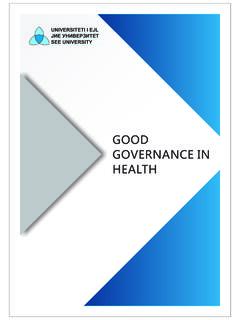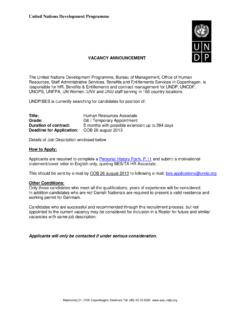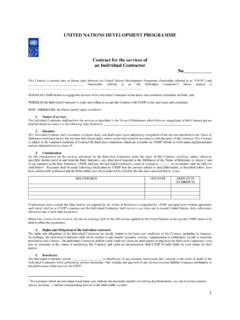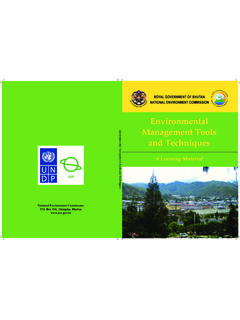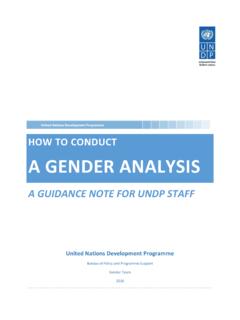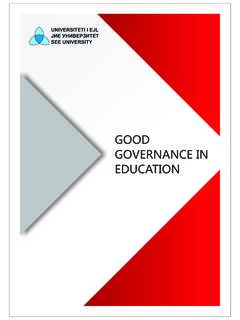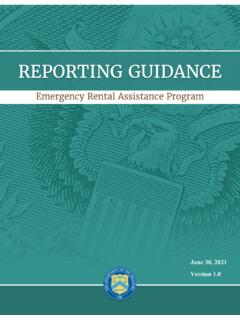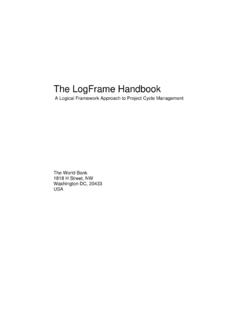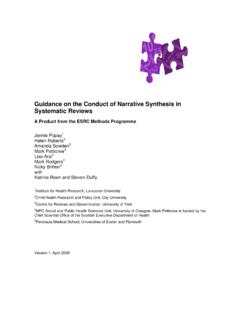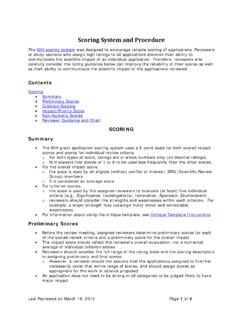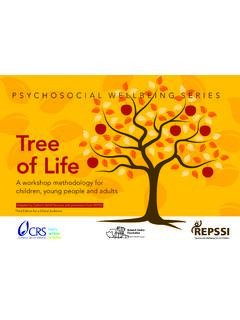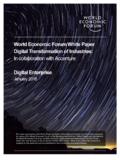Transcription of PROJECT COMPLETION REPORT - United Nations …
1 PROJECT COMPLETION REPORT This REPORT must be completed and signed by the Contact person The information provided below must correspond to the financial information that appears in the financial REPORT .. Please complete the REPORT using a computer. Please expand the paragraphs as necessary. The UN/ISDR secretariat reserves the right to reject any incomplete or badly prepared reports. The answer to all questions must cover the reporting period as specified in point 1. Description Name of beneficiary of grant contractUnited Nations Development Programme UNDP Sri Lanka : Name and title of the Contact personAnanda Mallawatantri, Assistant Resident Representative Environment, Energy and Disaster Management : Name of partnersMinistry of Disaster Management and Human Rights, Disaster Management Centre of Sri Lanka in the Action: TitleReaching the Unreachable- Enhancing Outreach Capacity for in Disaster Risk Reduction in Sri Lanka of the Action: PROJECT duration : S # PROJECT Duration Start Date End Date 1 Original agreement 01 Oct.
2 2008 31 March 2009 2 No Cost Extension 1 31 March 2009 30 June 2009 3 No Cost Extension 2 30 June 2009 15 Sep 2009 Target country(ies): Sri Lanka Final beneficiaries &/or target groups School children, Vulnerable community groups in Sri Lanka and the General public (if different) (including numbers of women and men): 1 1 It is difficult to estimate the beneficiary numbers for this particular PROJECT as theoretically all Sri Lankans would benefit from the awareness and advocacy campaigns it will be used for. 2 2. PROJECT Achievements Summary (Please provide overall PROJECT summary towards achievements and their expected impact. There is no set format; however, please be sure to include 1) a brief background of the issue addressed by your PROJECT , 2) major achievements during the implementation period, and 3) how results of different activities carried out under the PROJECT contribute to the larger goal of Disaster Risk Reduction) Background of the issue addressed by the PROJECT Sri Lanka faces many low impact high frequency disasters such as drought, floods, landslides and coastal erosion every year.
3 Most of the time communities affected by these disasters are living in remote areas of the country and have no access to information on the hazards and possible remedial measures they could take against these hazards. One of the main reasons for their low level of awareness on the disaster related issues is lack of avenues for them to access the information as most of the awareness creation programmes are limited to the major cities or peripheral town centres. Unavailability of facilities in villages to conduct awareness programmes and lack of facilities to transport exhibits to the remote villages have restricted the outreach capacity of disaster management related organizations such as Disaster Management Centre. Major achievements during the implementation period With the support of other UNISDR supported PROJECT Partnerships for Disaster Risk Reduction in Sri Lanka and the support of Bureau for Crisis Prevention and Recovery of UNDP, Disaster Management Centre was able to develop a standardized training manual that can be used for awareness creation programmes throughout the country.
4 Supplementary reading materials were also selected from a range of products available in Sinhala and Tamil (local languages). Therefore with the commissioning of the Mobile Awareness Generation Unit (MAGU) all pre requisites will be available for DMC to develop a national wide awareness creation campaign on disaster risk reduction. Even though the implementation of PROJECT activities got delayed by several months, that provided an opportunity for all the key stakeholders to debate over the usefulness of the MAGU and modify the facilities available with the MAGU to suit the exact needs of the country. By Mid November the Mobile Unit will be ready to with all the necessary equipments and the materials that are required to conduct programmes to suit the needs of different vulnerable groups living in Sri Lanka.
5 How PROJECT activities contributed to the larger goal of disaster risk reduction Disaster risk reduction is an unrealistic goal if causes of vulnerabilities to disasters are not being addressed properly. Lack of awareness is a major factor contributing to vulnerability. The MAGU will address the accessibility issues of key technical agencies to reach the most vulnerable communities living in Sri Lanka. Therefore it facilitates the awareness creation activities and in turn reduction of vulnerabilities of the country. Overall Strategy adopted for the implementation of the PROJECT The PROJECT was implemented under the National Implementation Modality of the UNDP in which the main implementing partners was the Ministry of Disaster Management and Human Rights in Sri Lanka.
6 As the Disaster Management Centre was coming under the MDM&HR the acceptance of the main disaster management institution to the concept of MAGU was ensured from the PROJECT designing stage. In addition to that possibilities to develop partnerships with disaster management stakeholders were always explored as the financial sustainability of the PROJECT initiatives depend on the ability of the DMC to develop partnerships with other stakeholders such as INGOs, NGOs and private sector companies. An enabling environment was created between the DMC and key private sector companies to develop partnerships. Therefore basically the PROJECT implementation strategy was of two fold; ensuring the national ownership of the concept and developing public private partnerships for ensuring sustainability of the initiatives.
7 3 Achievements against the strategic Objectives (Please highlight only outputs against each strategic objective) Objective Intervention Logic Title of Activity as reported above OUTPUT [achieved / not achieved, if not reason?] + Please quantify and give narrative assessment of results 3. Strengthened disaster risk reduction (preparedness, mitigation and response) capacities of local communities Capacities and mechanisms for disaster risk reduction at the community level strengthened. 1. Purchasing a caravan to be modified as a mobile training and awareness generation facility 2. Compile, translate and dissemination of information, education and communication materials in local languages 3.
8 Purchasing of equipments necessary for mobile training and awareness generation facility Achieved. A medium size lorry was purchased and is being modified to the specifications given in the Annexure 1. Achieved. Landslide prevention best practices were developed into posters and printed in Sinhala, Tamil and English. These posters were developed in collaboration with the main technical agency responsible for landslide research and risk reduction in Sri Lanka, National Building Research Organization. The posters will be displayed in schools, key government and semi government department buildings and other public places of the landslide affected areas of the country.
9 Achieved. As per the specifications given in Annexure 2, all the equipments necessary for the Mobile Awareness Generation Unit was purchased. Short / long-term impact of the PROJECT (Please describe is there any visible short term impact and / or what long term expected impact has been envisaged) In the short run the PROJECT initiatives will support the Disaster Management Centre (DMC) and other members of the National Disaster Management Coordination Committee (NDMCC) to increase their outreach to the most vulnerable communities living in most remote areas of the country as well as other vulnerable communities. On the other hand vulnerable communities, local government authorities and civil society organizations working in remote areas of the country will be able to develop their capacities to face disasters with higher degree of confidence.
10 As the MAGU is expected to deliver risk reduction related messages to communities gather in public places such as festivals, carnivals and fares, as a whole the Sri Lankans would benefit from the improved awareness on hazards and risk reduction techniques. MAGU will provide a platform for many organizations to develop innovative programmes to reach targeted communities as in the past there was no mechanism to deliver programmes developed using state of the art technologies for large number of people. It is evident from the lack of localized edutainment programmes available in Sri Lanka to address risk reduction initiatives. The newly created mechanism will enhance the abilities of innovative programme developers to reach previously unreachable communities through interactive and sophisticated programmes.



